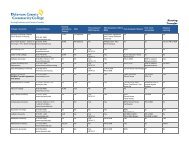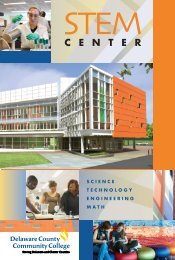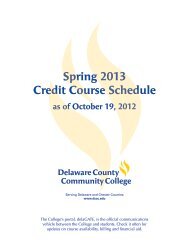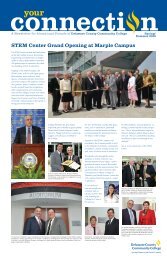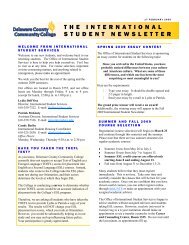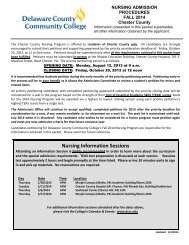2010 Catalog - Delaware County Community College
2010 Catalog - Delaware County Community College
2010 Catalog - Delaware County Community College
You also want an ePaper? Increase the reach of your titles
YUMPU automatically turns print PDFs into web optimized ePapers that Google loves.
140 COURSE DESCRIPTIONS<br />
MTT 214<br />
Milling Operations II<br />
This course is designed to provide theory and skill<br />
instruction supplemental to that introduced in Milling<br />
Operations I (MTT 124). Skill embellishment and<br />
expanded surface feature creation in the use of conventional<br />
metal working milling machines and attachments,<br />
along with associated accident prevention practices and<br />
procedures will be stressed. Concepts and mathematical<br />
calculations for machining of prismatic (cube-like) features<br />
and part geometry will be emphasized. Process planning,<br />
documentation and Geometric Dimensioning, and<br />
Tolerancing (GD&T) characteristics for milling work will<br />
be addressed. Cutters and insert (geometry and grade)<br />
selection, as well as cutting parameters, will be stressed.<br />
Upon successful completion of this course, students<br />
should be able to:<br />
• Utilize detail drawings, layout, and inspection tools to<br />
produce parts via horizontal and vertical milling operations.<br />
• Plan sequential operations and develop a process, a<br />
tooling, and an operation sheet, for advanced piece-part<br />
manufacturing on milling machines.<br />
• Develop set-up and inspection procedures for milled parts.<br />
• Compare milling machine cutting tool material types,<br />
and their selection criteria.<br />
• Research machinability factors and ratings for various<br />
types and classifications of materials.<br />
• Refer to manufacturer's catalogs and apply theory of<br />
cutting tools to determine the application, and the identification<br />
of cutting tool adapters, cutters, and inserts.<br />
• Determine coolant selection, speed, and feed settings in<br />
regard to tool material and insert geometry<br />
requirements in order to obtain specific surface finish<br />
requirements on milled parts.<br />
• Interpret print requirements (including GD&T) and part<br />
geometry for machining and inspection of advanced<br />
milling parts.<br />
• Create internal features to include chamfers, bores,<br />
recesses, counterbores, countersinks, grooves and<br />
pockets using a milling machine.<br />
• Set-up and use various style cutters to create form<br />
(profile) geometry such as angle, convex, concave,<br />
radius, T-slot, and key-way features.<br />
• Mount and use milling machine accessories and<br />
attachments such as a right angle plate, rotary table,<br />
dividing head, boring head, angular vise, angle plate,<br />
V-blocks, sine bar/plate/vise.<br />
• Position fixtures and perform fly cutting, slitting,<br />
straddle, and gang milling operations.<br />
Prereq. MTT 124<br />
3 Credits 2 Weekly Lecture Hours<br />
2 Weekly Laboratory Hours<br />
MTT 219<br />
CAM Solids I<br />
As a continuation of the principles of Computer Aided<br />
Manufacturing (CAM) design database development and<br />
usage, this course is designed to build on the course<br />
entitled Solids (CAM) Modeling (MTT 129). As such,<br />
instruction in this course will be centered around the<br />
theory and skills associated with the generation of 2<br />
through 2 1/2 axis Computerized Numerically Controlled<br />
(CNC) machine tool code generation. Specific tool assignment<br />
and tool path generation for CNC milling and profiling<br />
[router, water-jet, laser and like machines] as well as<br />
conventional, two axis, CNC lathes will be addressed.<br />
Upon successful completion of this course, students<br />
should be able to:<br />
• Conduct import and export, as well as other data file<br />
management and Distributed Networked Computer<br />
(DNC) operations.<br />
• Analyze geometry in order to develop tool path routines<br />
utilizing appropriate lead in/out and roughing moves to<br />
create desired features and surface quality.<br />
• Design and create libraries of commonly used<br />
machining operations, as well as modify operations to<br />
optimize tool paths for the improvement of part<br />
production efficiency.<br />
• Prepare piece-part modeling documentation, to include<br />
dimensioning; and, hard copy output.<br />
• Create tool paths for drilling, boring, and reaming on<br />
CNC mills and 2-axis lathes.<br />
• Develop, verify, and edit tool path, and CNC code, for<br />
single surface profile creation; as well as pocketing,<br />
island, and thin-wall surface and feature creation.<br />
• Generate roughing and finishing tool path for drilling,<br />
turning, grooving, facing, and threading (to include<br />
multiple lead) operations (inside and outside) on<br />
cylindrical parts.<br />
Prereq. MTT 129 Coreq. MTT 210<br />
3 Credits 2 Weekly Lecture Hours<br />
2 Weekly Laboratory Hours<br />
MTT 220<br />
CNC Programming<br />
This course is designed to provide the experienced<br />
Computerized Numerically Controlled (CNC) machine tool<br />
operator with instruction in manual part programming<br />
and advanced operations. Mathematical applications for<br />
definition of location, set-up, positioning and tool movement<br />
(absolute/incremental) within specific coordinate systems<br />
will be presented. Various aspects of intermediate to<br />
Advanced G and M code programming to include fixture<br />
offsets, thread milling, looping, macro, and sub program<br />
development/utilization/execution will be included. Criteria<br />
relevant to accident prevention practices and procedures,<br />
process planning, work-holding, tooling, machine set-up<br />
and operation, program proof-out, and quality control will<br />
also be addressed.<br />
Upon successful completion of this course, students<br />
should be able to:<br />
• Via manual methods, interpret and convert basic piecepart<br />
drawings in order to produce proceduralized<br />
manufacturing process/operation, workholding, tooling<br />
documentation sheets, and job plans for a CNC mill<br />
(router on similar machine tool) and a CNC lathe.<br />
• Apply principles of mathematics, engineering print<br />
interpretation and geometric analysis to describe part<br />
datum's, surfaces, and feature locations in terms of 2<br />
and 2 1/2, axis machine/tool positioning.<br />
• Prepare and proof a written manuscript for the<br />
production of parts on a CNC mill, (or similar machine),<br />
and a CNC lathe.<br />
• Utilize mathematical calculations, and concepts of<br />
geometric relationships combined with techniques,<br />
hardware, software menus and computer system<br />
practices associated with a Computer Aided<br />
Machining/Distributed Numerical Control (CAM/DNC)<br />
system to manually write, save, retrieve and transfer<br />
CNC machine tool programs.<br />
• Apply programming techniques (to include advanced<br />
canned cycle, loops, and macros).<br />
• Develop programs involving advanced operations such<br />
as helical interpolation and thread milling operations.<br />
• Program multiple and varied parts involving<br />
multiple operations per set-up to include the use<br />
of indexing devices.<br />
• Describe the purpose and use of charting as it applies<br />
to Statistical Process Quality Control (SPQC) in the CNC<br />
machining environment.<br />
• Discuss the principles and applications of parametric<br />
programming as they apply group technology part<br />
programming.<br />
Prereq. MTT 210<br />
3 Credits 2 Weekly Lecture Hours<br />
2 Weekly Laboratory Hours<br />
MTT 229<br />
CAM Solids II<br />
This course in advanced principles of Computer Aided<br />
Manufacturing/Machining builds on the skills and knowledge<br />
gained in CAM Solids I. Topics of instruction will<br />
include advanced (multisurface) part modeling and tool<br />
path generation for 3-axis milling (similar profiling)<br />
machines with additional positioning axis: and multi<br />
axis (mill-turn) lathes.<br />
Upon successful completion of this course, students<br />
should be able to:<br />
• Analyze 3D-parts geometry in order to conceptualize<br />
and create tool paths for prismatic (cube-like) part<br />
contours and blended multi-surface generation via<br />
3-axis milling.<br />
• Select an appropriate Computerized Numerically<br />
Controlled (CNC) machine tool for required piece-part<br />
production.<br />
• Structure a plan for approaching multi-part, same<br />
set-up, tool path generation for difficult to machine<br />
piece-parts.<br />
• Formulate a strategy, and generate axis positioning, as<br />
well as tool path code for 4th and 5th axis programming.<br />
• Generate tool paths for creating cross drilling,<br />
face contouring, and c-axis contours on mill-turn<br />
machine tool.<br />
• Customize a generic CNC machine tool post processor<br />
to produce desired machine/tool/program operation.<br />
• Robots software programming capabilities to consumer<br />
products and life style improvements.<br />
Prereq. MTT 219 Coreq. MTT 220<br />
3 Credits 2 Weekly Lecture Hours<br />
2 Weekly Laboratory Hours<br />
MTT 230<br />
Electrical Discharge<br />
Machining<br />
This course is designed to provide the student with the<br />
information and basic skills required to program and<br />
operate both ram (sinker), and 4-axis wire (EDM) Electrical<br />
Discharge Machining/machines. Instruction will address<br />
the fundamental principles of the EDM process, terms,<br />
capabilities, and machine tool system components. Aspects<br />
of programming and machining methodology, to include;<br />
work holding, tooling, electrode selection and operational<br />
characteristics, process variables, set-up and operation of<br />
ram and wire machines will be addressed.<br />
Upon successful completion of this course, students<br />
should be able to:<br />
• Cite in writing, the principles of operation for the<br />
EDM process.<br />
• Identify the function and the components, and<br />
operational characteristics, as well as the operation<br />
parameters, of typical ram and wire EDM machine tools.<br />
• Compare and contrast requirements for ram and wire<br />
EDM machine maintenance, set-up and operation.<br />
• Summarize the various types of electrode materials<br />
and designs, as well as their application.<br />
• Explain the design and operational characteristics a<br />
ram type electrode must exhibit in order to perform<br />
appropriately.<br />
• Interpret work order requirements and set-up a typical<br />
ram, and a wire EDM machine tool for production.<br />
• Set-up and operate a ram and a wire EDM machine<br />
tool in order to achieve desired inspection/quality<br />
characteristics on a finished part.<br />
• Analyze part geometry requirements and create<br />
Computer Numerically Controlled (CNC) piece-part<br />
programs, incorporating control of various processes<br />
and machining parameters for machining on a ram;<br />
and, a 4-axis wire EDM machine.<br />
• Utilize CAM software programming options to modify<br />
cutting parameters and settings, part geometry at<br />
various points on a contour.<br />
Conduct service and maintenance functions typically<br />
assigned to an EDM machine tool operator.<br />
Prereq. MTT 220 Coreq. MTT 229<br />
4 Credits 3 Weekly Lecture Hours<br />
2 Weekly Laboratory Hours<br />
DELAWARE COUNTY COMMUNITY COLLEGE




